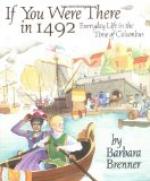At a very early age he became a student at the University of Pavia, where he laid the foundations of that knowledge of mathematics and natural science, which stood him in good stead throughout his life. At Genoa he would naturally regard the sea as the great field of enterprise which produced harvests of rich wares and spoils of glorious victories; and he may have heard, now and then, news of the latest conclusions of the Arabic geographers at Senaar, and rumours of explorations down the African coast, which would be sure to excite interest among the maritime population of his birthplace. It is not wonderful that, exposed to such influences, he preferred a life of adventure on the sea to the drudgery of his father’s trade in Genoa. Accordingly, after finishing his academical course at Pavia, he spent but a few irksome months as a carder of wool (tector panni) and actually entered on his nautical career before he was fifteen years old.
Early voyages of Columbus.
Of his many voyages, which of them took place before, and which after, his coming to Portugal, we have no distinct record; but are sure that he traversed a large part of the known world, that he visited England, that he made his way to Iceland and Friesland[7] (where he may possibly have heard vague tales of the discoveries by the Northmen in North America), that he had been at El Mina, on the coast of Guinea, and that he had seen the Islands of the Grecian Archipelago. “I have been seeking out the secrets of nature for forty years,” he says, “and wherever ship has sailed, there have I voyaged.” But beyond a few vague allusions of this kind, we know scarcely anything of these early voyages. However, he mentions particularly his having been employed by King Rene of Provence to intercept a Venetian galliot. And this exploit furnishes illustrations both of his boldness and his tact. During the voyage the news was brought that the galliot was convoyed by three other vessels. Thereupon the crew were unwilling to hazard an engagement, and insisted that Columbus should return to Marseilles for re-inforcement. Columbus made a feint of acquiescence, but craftily arranged the compass so that it appeared that they were returning, while they were really steering their original course, and so arrived at Carthagena on the next morning, thinking all the while that they were in full sail for Marseilles.
[Footnote 7: The account of this voyage to the north of Europe, as commonly quoted, furnishes a singular instance of the inaccuracy of translators in the matter of figures. Columbus is there made to say, that at the Ultima Thule, which be reached, “the tides were so great as to rise and fall twenty-six fathoms,” i.e. 156 feet. Of course this an absurdity; for no tides in Europe rise much above 50 feet. We have no record of the exact words used by Columbus, but in the extant Italian translation he is made to speak of the rise being venti sei bracchia, i.e.




